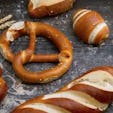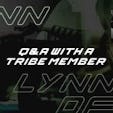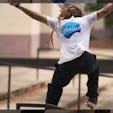If you’ve been doing bench presses and pushups since your first day in a gym (and if you’re a guy, you almost certainly have been), you’ve probably noticed that one area of your chest still lags behind the others. No matter how strong you get or how much you pump up your pecs, the innermost portions of the pec muscles—where the muscle fibers attach to the breastbone—seem to lack size and definition.
Rumor has it, however, that such development is genetic—you have the potential for it or you don’t. Some trainers say that an impressive inner chest is a product of steroid use, and that “natty” lifters just can’t isolate their pecs well enough to etch that kind of definition into their muscles.
But the truth is that—with dedicated, consistent effort—anyone CAN carve out a deeper inner-pec groove. Getting there primarily comes down to mastering three inner pec-focused exercises, and adding one chest workout per week to your routine.
Why Work Out Your Inner Chest?
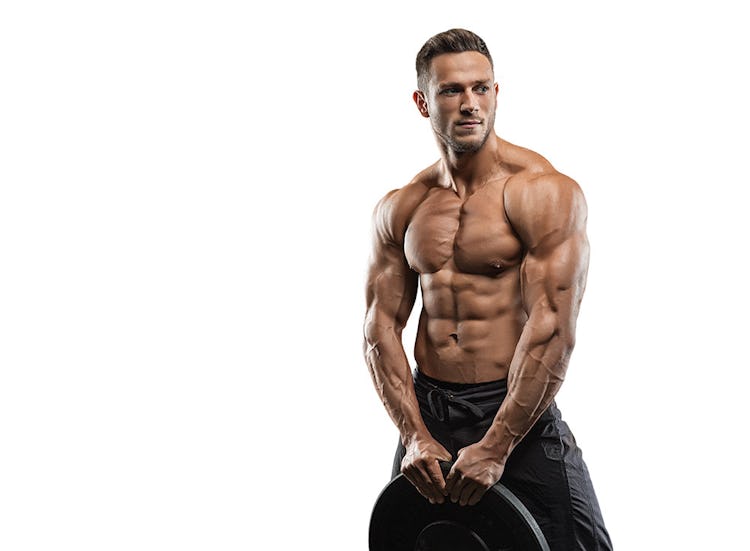
It’s easy to joke about “guy cleavage,” but most men can’t deny that they would like to have the lines and edges you see on the inner pecs of bodybuilders and physique competitors. Called striations, they make the chest look more imposing and complete, sending the message that you’re a serious lifter who’s put his/her time in at the gym—you’re not just another “bro” or poseur.
But trying to target a specific portion of any muscle is a touchy subject in the strength and conditioning community. “Once a muscle fiber is contracted, there’s an all-or-nothing phenomenon,” says John Rusin, D.P.T., C.S.C.S., creator of Functional Hypertrophy Training. “If you recruit some portion of the pec, you’re going to recruit it all.” In the case of the chest, the same nerves that control the inner part of the pecs activate all the other regions—the upper, lower, and outer pecs. “So, the science will tell you, no, you can’t truly isolate one part of a muscle. But there are ways to target the inner pec fibers to help build that area.”
Rusin says that by focusing your mind on contracting a specific area of muscle (what bodybuilders call the mind-muscle connection, see below), and using exercises that stress contractions in the places you want to target, it is possible to emphasize very specific portions of that muscle for potentially greater development.
Anatomy of the Inner Chest
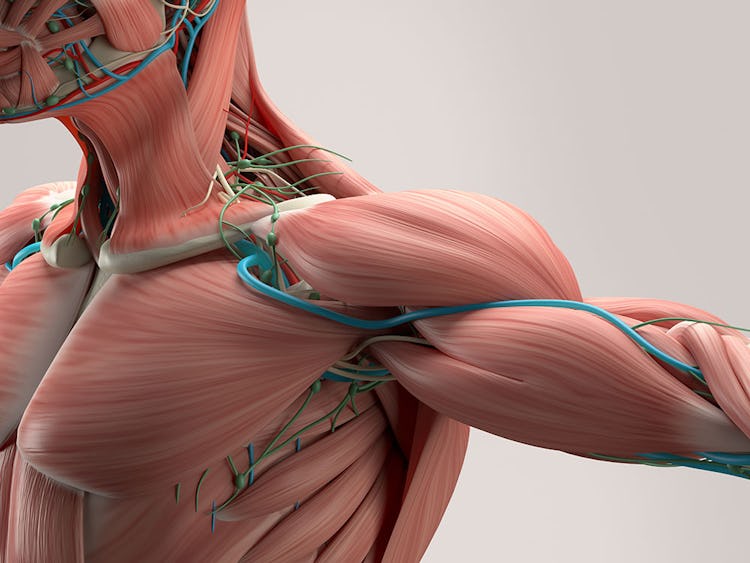
When it comes to working the inner chest, we’re technically only talking about one pair of muscles: the pectoralis majors. These are the big chest muscles that attach to the sternum. There’s a second pec muscle on each side—the pectoralis minor—but it’s smaller, and doesn’t reach the sternum, so it doesn’t need to be targeted when trying to bring up the inner chest.
The space between where the two pec majors attach at the sternum forms a vertical column. For a well-defined inner chest, these attachment points need to be as built-up as possible, so that each individual pec major is clearly separated from the other one and looks like it’s been carved out of granite. (You’ll have to be pretty lean as well for striations to show.)
There are four anatomical motions that the pec major performs:
- Flexion of the humerus (raising the arm in front of your body). This is accomplished by the clavicular head of the pec muscle—the pec fibers that attach to the collarbone.
- Extension of the humerus (lowering the arm down to your side). This is done by the sternocostal head—the fibers that attach to the sternum.
- Horizontal adduction of the humerus (moving the arm across the front of the body). Both the clavicular and steroncostal heads work together to move the arms in a hugging motion.
- Internal rotation of the humerus (rotating the arm in toward the midline of the body). Again, both muscle heads work together here.
In the gym, you can train all of these movements by using two types of exercises: presses and flyes. Pressing exercises, typically done with a barbell or dumbbells, are considered primary movements for the chest, because they give you the most bang for your training buck. As compound exercises, presses let you lift a lot of weight and activate a lot of muscle. But it’s the lifts that emphasize horizontal adduction (i.e. flye variations) that Rusin says are the most effective for targeting the inner pecs. “If you want to hit those inner fibers, you can’t just be doing bench press, dumbbell bench press, and standard pushups,” he says. “Horizontal adduction is the key to hitting the inner pecs, and it’s one action that most people never truly train optimally.”
Creating A Mind-Muscle Connection for Better Inner-Chest Gains
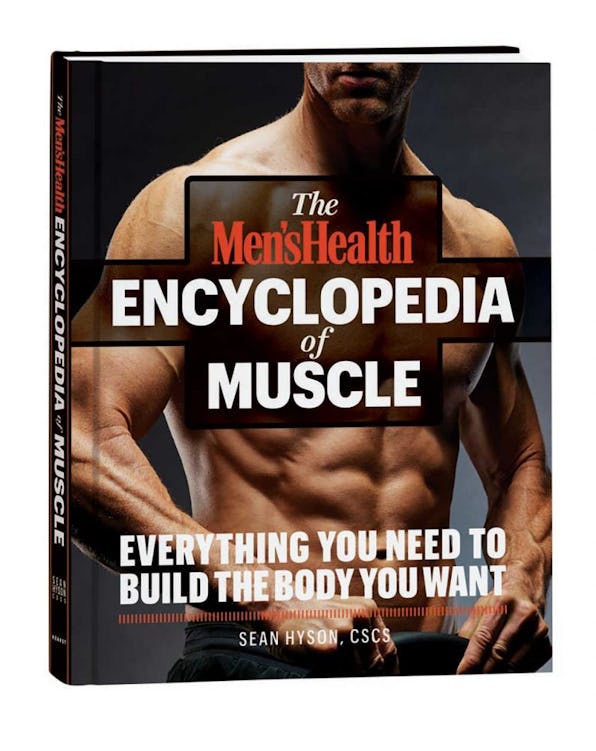
Bodybuilders speak of the mind-muscle connection as mentally zeroing in on the muscles you’re training to improve their activation. As former pro bodybuilder Ben Pakulski (mi40nation.com) explains in The Men’s Health Encyclopedia of Muscle, written by Onnit Editor-in-Chief Sean Hyson, C.S.C.S., to use the mind-muscle connection properly, you have to picture the two ends of the muscle coming together with each contraction.
In the case of the pecs, the muscles originate at the collarbone and sternum and insert on the humeral bones. When you do a press or flye movement, the insertion points pull closer to the origins. “When I train,” says Pakulski, “I’ll picture what my insertion looks like, and how I’ll bring that closer to the origin.” So, to get the most out of your inner-chest training, visualize the pec muscles’ connection at the top of your arms pulling toward the parts of the muscle that attach at your sternum. Imagine the inner portion of the pec fibers tensing and jumping out from your skin. It may sound woo-woo, but the mind undoubtedly has an effect on the body.
In 2016, a study in the European Journal of Applied Physiology had subjects use the mind-muscle connection during bench-press workouts. When the lifters visualized their muscles working, there was greater activation in the pecs and triceps. Also in 2016, a review in Strength and Conditioning Journal concluded that use of the mind-muscle connection could increase the effect of all factors that contribute to muscle growth, including muscular tension and overall muscle damage.
What Are the Best Inner-Chest Exercises?
Below are Rusin’s three favorite exercises for targeting the inner pecs.
1) Hybrid Flye-Press Combo
As the name implies, this exercise is a cross between a flye motion and a press. You maintain a neutral grip (palms facing each other) and perform an arcing motion with the arms, as in a flye, but you also bend your elbows quite a bit in the down position, like you do in a press.
“The hybrid flye-press combo really targets horizontal adduction at the top of the movement,” says Rusin. “This exercise goes against the belief that you have to do these really long moment-arm flyes,” that is, flyes where your elbows are almost fully extended. While some lifters think it helps them get a better stretch on the pecs in the bottom of the movement, that technique is dangerous for the elbows, and Rusin says it’s not necessary.
You can perform this hybrid move with dumbbells or cables, but Rusin prefers you use cables, because of the constant tension they provide. “With dumbbells, when the arms are in a vertical position, we lose our line of pull,” he says. That is, when your elbow and shoulder joints are stacked at the top of the movement, there’s no tension on the pecs—the weight is just resting on the joints. But when you use cables, the pulley system makes the weight continue to resist your muscles at every point in the range of motion, “and that keeps tension on the tissues through that portion of the movement.”
Note: The hybrid flye-press combo is NOT a standing cable crossover. Rusin wants it performed lying on either a flat bench or with a slight incline (the incline will emphasize those clavicular head fibers more, and therefore give you a better inner, upper-chest hit). “With standing flyes, people tend to compensate too much,” he says. “They increase upper back involvement, and they use the hips, when they should be concentrating on contracting the pecs to get the most out of them.”
How To Do the Hybrid Flye-Press Combo
Step 1. Set an adjustable bench at a slight incline (15–30 degrees), equidistant between two cable columns. Attach single-grip/stirrup handles to the pulleys at the lowest positions.
Step 2. Grasp both handles and lie back on the bench. Your elbows should be bent about 90 degrees. The pulleys should be in line with your shoulders so that the cables run more or less perpendicular to the weight stacks; if this isn’t the case, scoot the bench either forward or backward. If you like, rest your feet on the bench, which will add an element of instability to the exercise.
Step 3. Press the handles up while drawing your hands together so that they nearly touch at the top and your arms are fully extended over your upper chest. Squeeze the contraction hard, visualizing your inner pecs doing the work, and then slowly lower your arms to the start position.
2) Hammer Squeeze Press
Like the flye-press combo exercise, this move combines a pressing movement with an added focus on horizontal adduction, courtesy of squeezing a light medicine ball between your hands.
“This exercise is fricking amazing,” says Rusin. “It will instantaneously activate that portion of the pecs we’re talking about. It’s something that will get you sore in the right kind of way, especially in that inner-pec area. This will blow you up.”
How To Do the Hammer Squeeze Press
Step 1. Set a bench to a 15 to 45-degree incline and hold a pair of moderate-weight dumbbells with a light medicine ball secured between them. The purpose of the medicine ball is simply to have something to squeeze, not to provide additional resistance, so find the lightest ball possible—preferably a leather or Kevlar one that will stay in place and not slip out. (Have a partner place the ball between your hands and squeeze your hands together, or bear hug the ball with the dumbbells and then get into position.)
Step 2. Set up on the bench with your arms extended straight upward and palms facing each other. Press in on the ball by contracting the inner pecs and hold it isometrically. Think about your inner-pec fibers firing hard throughout the whole exercise.
Step 3. Maintaining the squeeze, bend your elbows to lower the dumbbells and ball down to your chest.
Step 4. When the ball touches your upper chest, press back up under control to the arms-extended position, squeezing the ball hard throughout.
3) Diamond Pushup
All pushups are underrated chest-builders. A simple way to target the inner pecs with a pushup is to narrow your hand spacing into what’s commonly known as the “diamond” position: the tips of your index fingers and thumbs touch each other, or close to it, forming a diamond shape between your hands. This will also activate more triceps muscle as well.
“The hardest muscle to build is the one you can’t feel,” says Rusin. “That’s why I like using the diamond pushup. You can feel that inner-pec area working, so you’re more likely to be able to build that area.”
How To Do the Diamond Pushup
Step 1. Assume a standard pushup position with your hands and toes on the floor and your body in a rigid, straight line from heels to head.
Step 2. Move your hands together so that the ends of your index fingers and thumbs are nearly touching each other (the exact distance between them should be whatever feels comfortable to you and won’t aggravate your elbows). The space between your hands will resemble a diamond shape.
Step 3. Bend your elbows to slowly lower yourself toward the floor. When your chest touches your hands, press back up explosively to full elbow extension. As you press up, try to draw your hands even closer together but without actually moving them—just tense the muscles and focus your mind on contracting the inside of your chest.
How Can I Stretch My Pecs?
Rusin doesn’t recommend stretching the pecs before or after workouts. “The shoulder is the most mobile joint in the body,” he says, “so rarely do we need more mobility there.”
He does, however, recommend one stretching technique during a chest workout to increase overall muscle activation, including the inner-pec fibers. He calls it “loaded stretching,” and it’s best utilized on the hybrid flye-press combo exercise.
Here’s how to do it: On your last set of flye-presses, after reaching muscle failure, lower your last rep down as slowly as possible. When you reach the bottom of the range of motion, hold that position for as long as you can (aim for 30 seconds). “This will light up every aspect of your pecs,” says Rusin.
Stretching a muscle under load creates even more tension in it, stimulating a growth response. Loaded stretching is another concept that is explained in The Men’s Health Encyclopedia of Muscle.
Beginner Inner-Chest Workout
The following workout, designed by Rusin, can be done once a week in place of your existing chest workout. You can also train other muscles (i.e. triceps, back, or shoulders) after your chest work in the same session. For the best gains in chest size, you should work your pecs one other day in your training week, either with the same exercises or other chest moves of your choice.
“You’re not training for power and strength with the inner pecs,” says Rusin. “This workout is about hypertrophy [muscle gain], so we’re going to implement higher reps on the inner-chest exercises and more total volume to deliver a good pump. You’ll definitely feel the inner chest working.”
1. Hammer Squeeze Press
Sets: 3 Reps: 12–15
See directions above.
2. Barbell Bench Press
Sets: 3 Reps: 3–8
Step 1. Set up in a power rack if you’re training alone, so you can set the spotter bars to just below your chest to catch the barbell if you can’t press it up. Draw your shoulder blades down and together to arch your back. Place your hands about shoulder-width apart on the bar.
Step 2. Pull the bar out of the rack without losing your arch and shoulder position. Lower the bar to your chest, right at the nipple line, tucking your elbows 45-degrees on the descent.
Step 3. Press the bar to lockout.
3. Cable Hybrid Flye-Press Combo
Sets: 3 Reps: 10–15
See directions above.
4. Diamond Pushup
Sets: 2 Reps: To failure
See directions above.
Advanced Inner-Chest Workout
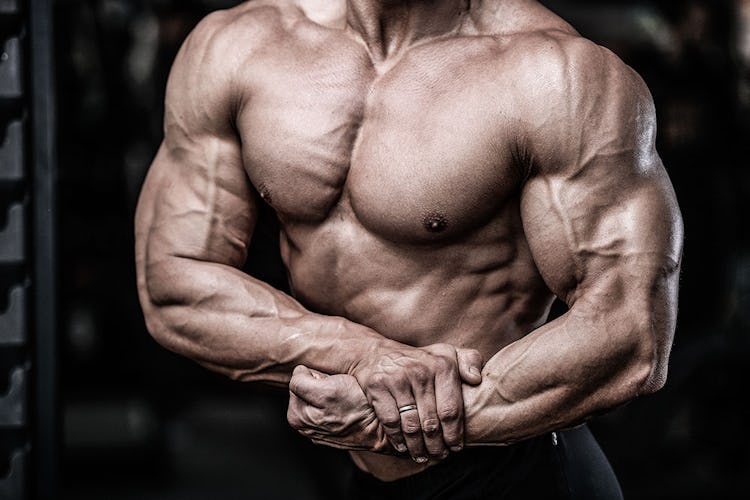
Also designed by Rusin, this chest routine can be done once per week. The extra volume (and a more advanced diamond pushup variation) makes it slightly more challenging than the beginner’s routine above, but it’s still based on the same exercises that offer the best inner-pec hit.
1. Hammer Squeeze Press
Sets: 4 Reps: 12–15
2. Barbell Bench Press
Sets: 4 Reps: 3–8
Step 1. Set up in a power rack if you’re training alone, so you can set the spotter bars to just below your chest to catch the barbell if you can’t press it up. Draw your shoulder blades down and together to arch your back. Place your hands about shoulder-width apart on the bar.
Step 2. Pull the bar out of the rack without losing your arch and shoulder position. Lower the bar to your chest, right at the nipple line, tucking your elbows 45-degrees on the descent.
Step 3. Press the bar to lockout.
3. Cable Hybrid Fly-Press Combo
Sets: 3 Reps: 10–15
4. Feet-Elevated Diamond Push-Up
Sets: 3 Reps: To failure
Perform the diamond pushup as described above, but rest your fee on a bench or other elevated surface so that your torso is angled down toward the floor.
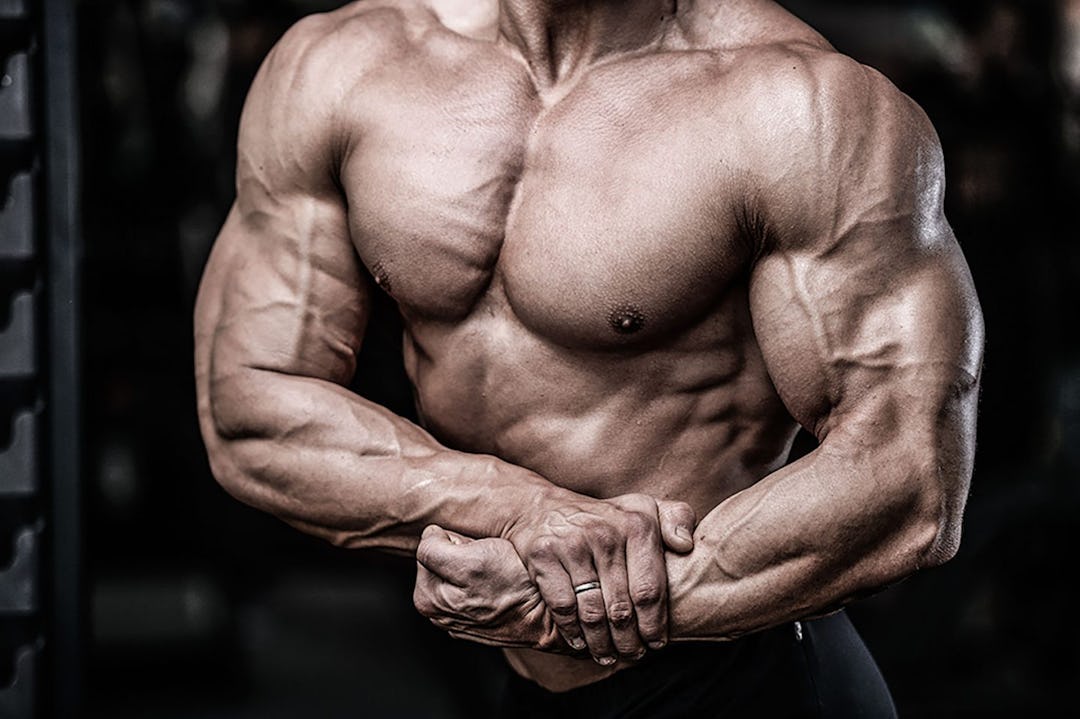
)

